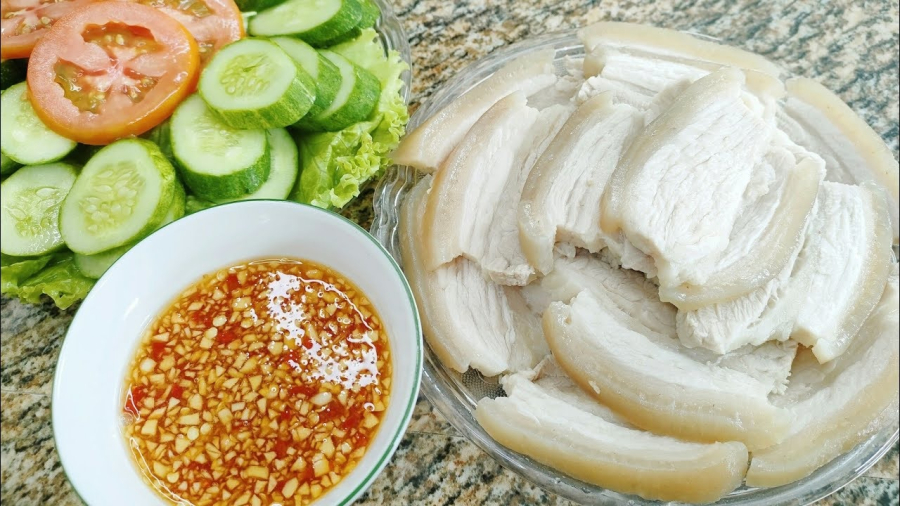Many people encounter a situation where, after boiling pork, they take it out and continue with other tasks, only to realize later that the meat has lost its appeal and turned dull. To prevent this, there are a few tricks to keep in mind.

The Secret to Boiling Tender and White Meat
The Secret to Preventing Meat from Turning Dull
The discoloration of boiled pork is a result of oxidation, a chemical reaction between the components in the meat and the air, which causes it to turn dull. Oxidation occurs with all types of cooked meat, but it is more noticeable with boiled pork due to the contrasting shades.
There are several things to keep in mind if you want to prevent boiled pork from turning dull:
Boil Meat in Cold or Hot Water Depending on Your Goal
Each method has its pros and cons. Boiling in hot water causes the meat fibers and outer proteins to contract and clump together quickly, trapping any impurities inside. However, this method results in sweeter and more flavorful meat as it retains more nutrients. On the other hand, boiling in cold water from the start helps eliminate impurities, but you need to skim the foam frequently. The advantage of this method is that the resulting broth is sweet and fragrant, perfect for making soups, but the meat may not be as sweet and tender as the previous method.
Add Spices to Enhance the Flavor of the Meat
When boiling, add a few crushed cloves of garlic, a pinch of seasoning powder (salt), seasoning, pepper, and white wine to the pot. This not only helps to eliminate any unpleasant odors but also enhances the sweetness and fragrance of the meat. Garlic and white wine are particularly effective in masking odors, so if you’re using lower-quality meat, this is a great way to transform it into a delicious dish.
Soak the Meat for Better Taste and Whiter Color
To prevent the meat from turning red, after boiling it for 10-15 minutes, turn off the heat, cover the pot, and let it sit for another 10-15 minutes, depending on the size and weight of the meat. This ensures that the inside of the meat (especially for tied pork hocks) doesn’t turn red and cooks evenly, resulting in tender and sweet meat. After boiling, place the meat in a bowl of hot water to cool down, then add ice cubes and a few slices of lemon to make the skin whiter and crispier.
3 Things to Add When Boiling Meat to Make it More Nutritious and Help Prevent Cancer
1. Add crushed garlic cloves, white wine, and a few slices of fresh ginger:
These ingredients are not just for pre-boiling. They are essential for the second boil as well. Additionally, add a pinch of seasoning powder (salt), seasoning, pepper, and white wine to enhance the flavor and sweetness of the meat. These ingredients also help the meat release excess substances, ensuring a nutritious and healthy dish.
2. Add ginger or lemongrass:
These two ingredients not only eliminate any unpleasant odors but also make the meat fragrant. They are especially effective in removing toxins from the meat.
3. Add salt or vinegar:
These condiments enhance the flavor and sweetness of the meat while also making it more nutritious.

Choosing to boil meat in cold or hot water is a great kitchen tip that can make a difference in the flavor of your dish.
The most common method of boiling meat is to use cold water. However, when using cold water, it’s essential to blanch the meat first to remove any impurities and skim off the foam. This ensures that the broth from the second boil is clean, clear, and fragrant, making it perfect for cooking soups. On the other hand, boiling meat in hot water allows you to cook it immediately after cleaning. While this method may trap some impurities, it results in sweeter and more flavorful meat that retains more nutrients.
However, it’s recommended to boil meat in hot water only when you’re confident about the quality and safety of the meat or if the animal was raised in a controlled environment.
Should You Use Meat Broth for Soup or Discard It?
Meat broth is a versatile liquid that can be used in a myriad of ways. While some people choose to discard it due to its high fat content, others recognize its potential as a flavorful base for vegetable soups or other culinary creations. The question arises: What is the best way to utilize meat broth?







































